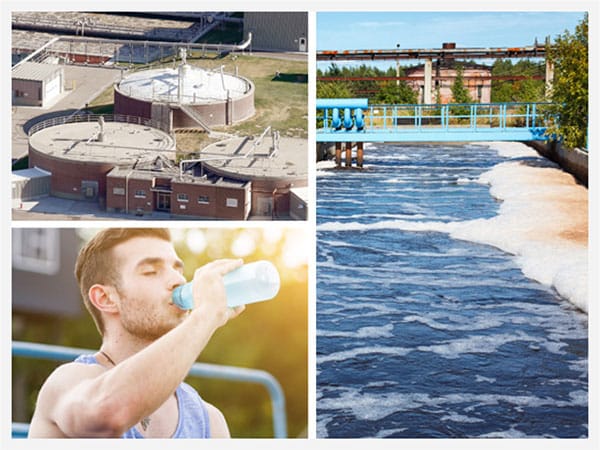

By Tim Hanna, PRAB Vice President of Business Development
Modern manufacturing operations are constantly looking for ways to innovate and increase productivity. This means making the most efficient use of any resource essential to the process. These resources, which can be finite commodities whose prices can fluctuate dramatically each year, often can be the drivers for increasing unplanned expenses, lowering efficiency, and impacting annual profits.
Water is considered an essential resource for many manufacturing operations, as well as being one of the most heavily regulated. In an effort to trim expenses and comply with ever-tightening federal, state, and local regulations, industrial wastewater treatment has become a critical focal point for modern plant operations.
For many years, a lack of regulations allowed U.S. water quality to diminish and endanger the population. In the 1920s, the treatment of drinking water was the priority – with wastewater treatment taking another two decades to emerge1. With the passage of the Water Pollution Control Act in 1948, the federal government decidedly entered a sector historically controlled by state and local governments. Since the establishment of the United States Environmental Protection Agency (USEPA) in 1970, federal influence over water quality has steadily increased. The passage of the Clean Water Act in 1972 and the Safe Drinking Water Act in 1974 remain the two primary federal statutes addressing water quality2.
It is estimated that approximately 20% of the world’s population is without clean water, and half of the people on the planet will suffer from severe water shortages by 2050. This puts tremendous pressure on governments to continue to regulate and manage this valuable finite resource. In the U.S. alone, energy, farming, and manufacturing sectors consume about 300 billion gallons of fresh water every day.

Facing unprecedented population growth and an insatiable appetite by major economic sectors, water supply systems – including wastewater and sewage treatment systems – have failed to keep up with the need. The American Water Works Association’s State of the Water Industry report for 2015 lists renewal and replacement of water and wastewater infrastructure at the top of the five most important issues faced by the U.S. water industry.3
In 2015, the average monthly cost of water across 30 major U.S. cities rose by 6%, outstripping the consumer price index by more than 4%4. U.S. water prices have increased by 41% between 2010 and 20155. With no end in sight for water demand, and minimal governmental support available for updating treatment capabilities and expanding capacity, modern manufacturing operations must accept that the burden is on them to adapt. Failing to meeting regulatory compliance guidelines can impede future growth of the business, profits and overall sustainability.
Manufacturing operations are in the business to make a profit. Yet, it can be extremely difficult to map out how to achieve profitability each year when your budget must absorb unplanned expenses such as excessive tool wear, machine downtime, extra housekeeping, costly fluid disposal, or compliance fines.
With the average operational cost of water increasing at a rate of more than 6% annually in the U.S., the writing is on the wall for manufacturers to get a handle on their water use. It may seem easier for a business to overlook the increasing cost for an essential resource such as water and chalk it up to the cost of doing business, or perhaps, simply pass the expense along to its customers.
In an increasingly competitive global market, even the smallest increases can mean losing a client or inching closer to negative revenues. Casually accepting cost increases on primary resources like water can put extraordinary stress on other parts of the operation to make up for those increases. If other areas of the process are unable to achieve their goals – and thus are unable to make up for the increasing cost of water – a steady pattern of decreasing profitability emerges that can quickly spiral in just a few quarters.
In addition to the front-end expense of water, manufacturing operators must also contend with the challenge of dramatically increasing operational costs for wastewater. The days of allowing process run-off water to flow down a sewer drain have long been outlawed by federal regulations. In the past 45 years, there have been dozens of federal addendums to the 1972 Clean Water Act. Each of those additional regulations addresses a new concern, a new danger, or a potential danger to the environment and the population.
Over the decades, there has been a diminishing level of federal government spending to help keep wastewater infrastructure development on pace with new regulations. Flint, Michigan, is an example of how (with a lack of federal funding) a fiscally challenged local government that is ill-equipped to handle critical water treatment can opt for the “affordable” solution, only to find out the human cost can be profound.
Challenges facing wastewater treatment professionals include:
With federal financial support lacking, the onus falls to the state, regional, or local governmental bodies. All of them are unprepared to handle the cost of significant wastewater infrastructure improvements, or to figure out how to supply safe water to their citizens.
As state and local regulations are passed to ensure safe water for the population, new wastewater treatment regulations are added. Unable to shoulder the costs for enhancements to infrastructure capacity or capability, the burden then is passed on to businesses to adjust their processes to ensure compliance. This effectively builds in the cost of changing compliance measures at the expense of private business’ profits.
With so many variables for different manufacturing processes, as well as the differences in local regulations across the nation, there is no all-encompassing solution. Businesses must be acquainted with, and mindful of, their wastewater composition and how it should be treated to achieve full regulatory compliance.
The burden of compliance is on businesses, which must:
For more than four decades, the U.S. has consistently added new regulations and essentially instructed manufacturing operations to “make it work.” In a highly competitive market, there seems to be two options: continue to add in the expense of new regulations at the cost of diminishing profits, or find a way to address wastewater that leverages technology and innovation to create a new process – and a new model for profitability.
When the cost for wastewater compliance puts operating permits and profitability at stake, stepping up the focus on water resources becomes a critical priority. If the volume of water required for an operation is non-revisable, or the access to adequate quality water is minimized, implementing water recovery and reuse strategies like those offered by PRAB can be a solution to both challenges.
The first thing to understand is that there is no one solution to every company’s water situation. Each facility must be taken as an individual case and analyzed against the regulations in place for the processing site. Different areas of the country require different water treatments. Regulations are dynamic and tied to each location. A small community may have small capabilities, putting more responsibility on a company to meet/address water treatment in its process.
Understanding the composition of an operation’s wastewater is the first step in creating a viable solution. PRAB will evaluate previous laboratory analyses of wastewater or recycling streams, as well as the local discharge limits on the operation. Knowing the history behind previous wastewater challenges and solutions is essential to addressing current problems. Understanding all of the variables, having a willingness to innovate, and being able to employ the use of modern technologies are what make PRAB a global leader in wastewater treatment.


Filtration for industrial water encompasses many different technologies that efficiently remove hazardous or undesirable contaminants. PRAB’s approach to wastewater applications involves discussing and analyzing data and samples to choose the best solution. By using the PRAB Separation Spectrum Chart, all possible options are presented for further discussion. PRAB has a cadre of established technologies and proven solutions. Most PRAB systems deliver payback in less than one year, which means capital dollars invested are justified and recouped quickly.
The full line of PRAB wastewater filtration equipment starts with a simple paper bed filter and magnetic separator, and moves through vacuum filtration and ultrafiltration technology.
PRAB has been effectively handling wastewater treatment for more than 35 years. With a thorough appreciation for the value of water, combined with the engineering capability to help filter, recycle, and reuse a large percentage of existing wastewater, PRAB can design a comprehensive system for wastewater filtration that meets the needs of any facility. These systems, whether simple for particle removal or more complex for finite liquid/liquid separation, are all engineered based on each customer’s unique application and specific water analysis requirements.

Financial constraints on municipal water treatment plants are expected to continue, and there is no end in sight for the increasing demand and costs for quality water. Companies that choose to be proactive about their water management will stay one step ahead of the compliance curve while ensuring that a critical resource for daily operation stays reliable and intact. PRAB specializes in solving fluid management issues and increasing customers’ profitability with standard or custom-engineered coolant or wastewater filtration and recycling systems.
Wastewater violations and a repeated inability to comply must be met with a strong effort to show intended remediation of the process or processes causing the violations. There are several variables to recognize in order to effectively remedy any wastewater challenge. PRAB understands how to identify the keys to wastewater compliance and offer effective, proven solutions. The process starts with providing competent testing and design engineering, combined with pilot equipment for most technologies offered to minimize risk. It ends with PRAB helping companies increase their water reuse while reducing disposal costs by 90%.
Tim Hanna is the Vice President of Business Development for PRAB, a leading designer and manufacturer of wastewater recycling systems as well as engineered conveyors and equipment for processing turnings, chips, and metalworking fluids. Since graduating from Northwood University with a Marketing degree in 1970, Hanna has worked closely with companies and communities around the world who take advantage of the latest fluid filtration and chip handling technologies to both lower cost and increase environmental stewardship.